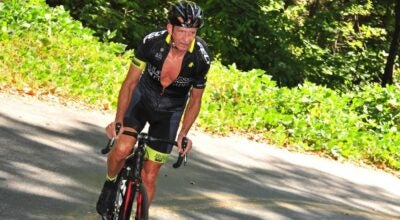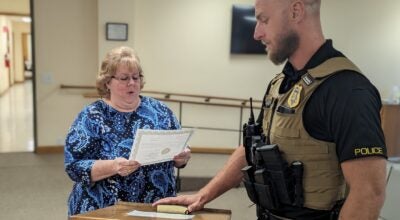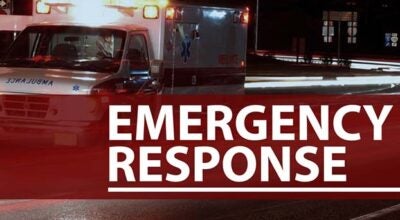Numbers will guide when and if prep sports return
Published 9:58 am Thursday, May 28, 2020
|
Getting your Trinity Audio player ready...
|
By Andy Rhinehart
It only took seconds after Que Tucker’s opening statement to media Tuesday for the question on the minds of high school athletic supporters across North Carolina to be asked.
Namely, what has to happen for prep sports in the state to resume in August, some five months after being shut down due to the global coronavirus pandemic?
Tucker, North Carolina High School Athletic Association Commissioner, had thoughts at the ready.
“I think what it will take will be to get us a vaccine, to get the numbers in a position where the Department of Health and Human Services and our governor feel they need to be in order for us to begin sports as we know them in August,” Tucker said.
“Obviously, it would be our goal that the stands could be as full as they always have been on a Friday night in every community for football, that we would not have any issues when our guys take the field to play soccer, that the gymnasiums could be full for volleyball and everything that we play typically in the fall.
“I’ve listened to the governor and (NCDHHS Secretary) Dr. (Mandy) Cohen over the last several weeks as they’ve shared it really is about the numbers, it’s about how our numbers are doing, what needs to be done based on the formula based on those things that Dr. Cohen and Governor Cooper have used as we’ve moved along in this process. So we will depend on them to help us with that.”
Tucker met for almost an hour with media members across the state, primarily to announce the NCHSAA Board of Directors’ decision to extend the current dead period for all sports through June 15. During a dead period, school personnel cannot organize activities for students.
But Tucker also said that the board directed NCHSAA staff as well as the Sports Medicine Advisory Committee to begin finalizing plans for what happens after June 15 with an eye on allowing coaches and players to begin holding organized workouts.
“It is the goal of the NCHSAA to provide these guidelines for safe return to our member schools in advance to allow (each local education agency) appropriate amounts of time to implement check-in and check-out procedures for workouts, providing screening for COVID-19 and education to coaches relative to how to maintain appropriate social distancing while providing our students with an opportunity to resume conditioning and training activities with their teammates,” Tucker said.
“We know that these workouts will look different than most traditional summer workouts, and we want to make sure that our full membership is on the same page about what is allowed and what is not. As you know, this is unprecedented territory, and while we hope to return to activities in mid-June, we know that conditions change rapidly relative to this virus. It really has a mind of its own.
Tucker tackled a number of other topics during the call:
On the financial impact of not playing football this fall or playing without fans: “It would be serious. I don’t think there’s any question that football is very important in terms of the financial viability of most athletic programs.
“So to not be able to have any fans in the stands would just be really, really tough. We’ve had some discussions with our city-county athletic directors to then be able to get to a point where we can say, alright, it looks like football is not going to happen as we know it, what are we looking like, what kind of hit would we take. So we will give ourselves some time, as our board discussed (Monday) night. We’re not at the point yet where we’re folding up the tent on football for this fall, but we are hopeful that at least we can have some fans and then we’ll have to figure out how that plays out.”
On whether all sports will resume activities after June 15: “The intention is that if we get to June 15th and it looks like we’re ready to begin Phase 2, as we’re calling it. . . the intention is that all sports would be able to resume some type of activities. The intention is that there would be no contact, so that we wouldn’t have football as we are thinking about it where we’ve got to have the contact. Wrestling, they would not be able to wrestle live wrestling that body-to-body contact in live wrestling.
“But there is no reason why there could not be physical conditioning drills, and I think if you read in the document, it speaks about how you can do some of those things with the idea that when and if we can play, then we will have been able to participate in some of those lead-up activities. “On playing sports such as football in a different season: “I can tell you that moving sports seasons is a last resort. That’s not where we are. We do not think that it is even wise to even talk about trying to move sports seasons right now. Our sports medicine doctors have said that it’s just too early to talk about that so we we’re not really entertaining that as an idea now.”
On possibly shortening the fall season: “Once we get to September and we get deeper into September, and if we’re just starting, then obviously we would be looking at shortening the regular season. We always try to operate with the end in mind, knowing when we’d like to end fall sports, and then we typically work our way to the beginning. If we’re delayed on when we can start sports, we would look at shortening the regular season. Depending on how deep into September we could conceivably go, then it might mean that we’d have to look at fewer teams in the playoffs. Nothing is off the table and shortening the seasons, shortening the number of contests are certainly part of this.”
On having games with limitations on the number of fans: “That to me is getting down into the weeds of what would happen at the various venues.
“If we are at a point where we say, okay, we can reduce the number of fans who can get into the stadium, then what would that reduction be? It would be a reduction that we would be guided by the Department of Health and Human Services. They would help us with that. Our sports medicine advisory committee must know, are we talking 50 percent capacity of your stadium on your visitors’ side and 50 percent on the home side? Then it would become the responsibility of that school then to figure out how you social distance in a stadium where you can only allow 50 percent capacity, how you do that and then do it using diagrams to make sure that that happens.
“Now the hard part comes is how you determine which 50 percent gets in. That obviously would be something that we would not tell our schools how to do. But certainly we would be willing to be at the table as our athletic directors, principals try to figure out how to make that work so that you don’t have the communities mad at you. We know that Friday night football is a big deal in just about every county in this state. When you start saying to certain people that well, you’re not gonna be able to get into this home game, then that becomes problematic. So how do you do that in an equitable manner?”





